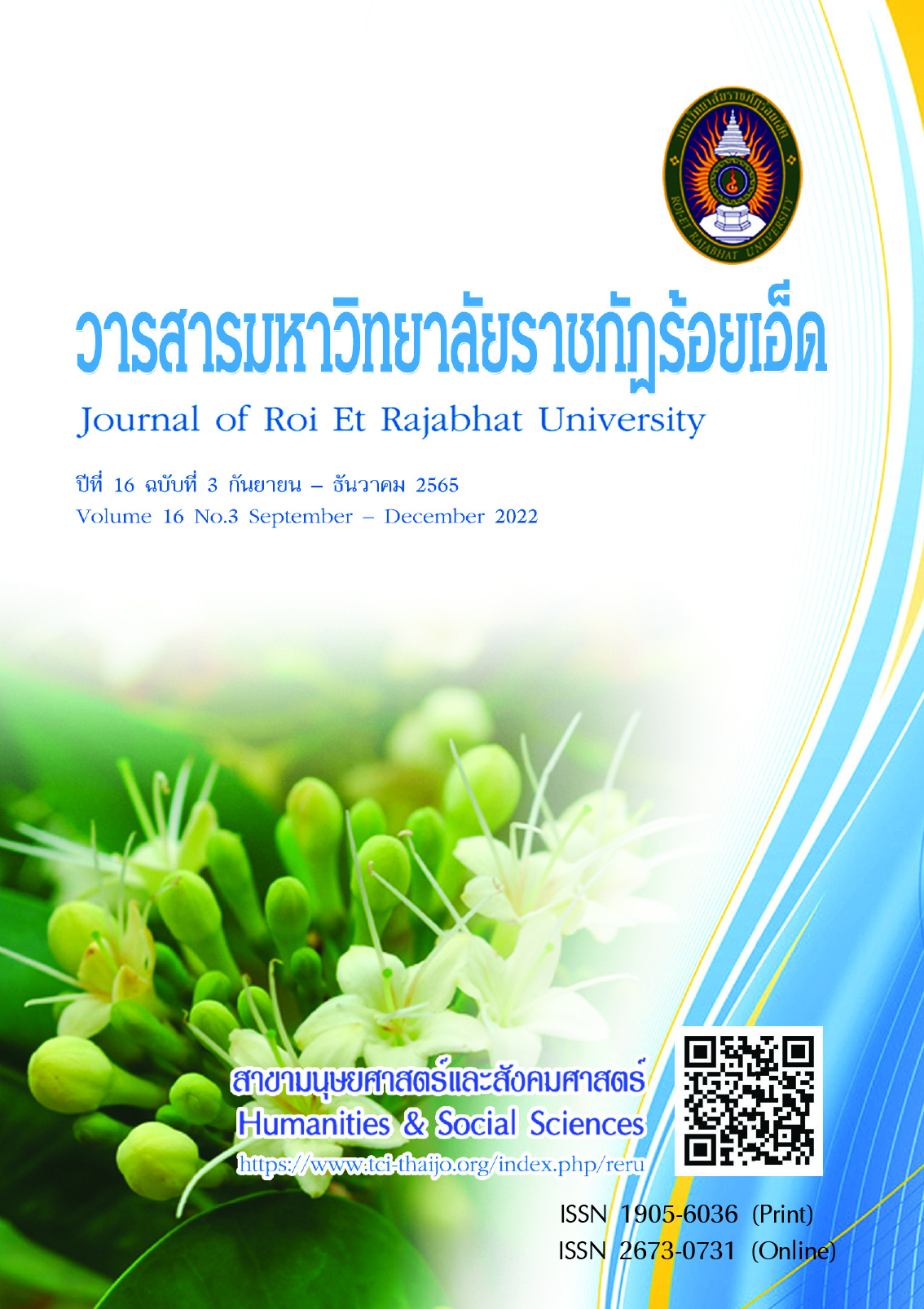A Study of Ethnics Identity to Promote Tourism in SANUK Provincial
Keywords:
Identity, Ethnics, TourismAbstract
This participatory action research had three main objectives; 1) to study tribes’ contexts,
2) to examine the identity and explore formation of the identity and the invention of tribes’ cultural data system, 3) to analyze ways of value creation for the tribes’ identity, to develop a cultural village, and
to promote tourism. The population in the research was the Thai Yoi tribe in Sakon Nakhon Province,
the Thai Saak tribe in Nakhon Phanom Province, and the Thai Kha tribe in Mukdahan Province. The sample group used in the research consisted of 3 groups of 105 people, consisting of 10 community leaders from each tribe, 20 community members from each tribe, and five representatives from government agencies for each tribe. Research instruments for data collection were observations, in-depth interviews, focus group, SWOT analysis, mind-mapping, and interpretative analysis. The study results suggested that the tribal Ethnics of SANUK Provinces (Sakon Nakhon, Nakhon Phanom, Mukdaharn)had beautiful landscapes surrounded by nature. They had their own cultural identities, which have been inherited from ancestors to descendants. Such inherited identities are included in traditions, beliefs, amusement, languages, handicrafts, and ways of life. Exchanging and learning forums for the tribal members were managed. The researchers also innovated the information related to the tribes’ identities as an electronic database and published media. Moreover, from the analysis of the potential of indigenous people’s identity, it was found that woven and basketry handicrafts were outstanding handicrafts of the Thai Yoi and the Thai Saak tribes. The wisdom of the root healer was the outstanding wisdom of the Thai Kha tribe.It can create added value as unique tourism products. The physical characteristics, traditions, cultures, ways of life of the indigenous people can create added value as tourism activities that will impress tourists.
References
กาญจนา นาคสกุล. (2552). ภาษาไทย: ชุดคำไทย. กรุงเทพฯ: สมาคมครูภาษาไทยแห่งประเทศไทย.
ฉัตรทิพย์ นาถสุภา และเรณู วิชาศิลป์. (2552). การศึกษาประวัติศาสตร์ไทอาหม. กรุงเทพฯ: สร้างสรรค์.
บุญเพรง บ้านบางพูน. (2527). ศรัทธาพลังชุมชน: ข้อคิดและประสบการณ์ในงานพัฒนาชนบท. กรุงเทพฯ: สํานักเลขาธิการ สภาคาทอลิกแห่งประเทศไทยเพื่อการพัฒนา.
พระไพรวัน มาลาวง และพระมหาดาวสยาม วชิรปัญโญ. (2563). วัฒนธรรมทางคติธรรมของชุมชนลุ่มแม่น้ำโขง. วารสารมหาวิทยาลัยมหากุฏราชวิทยาลัย วิทยาเขตร้อยเอ็ด, 9(1), 463-472.
ยรรยง จิระนคร และรัตนาพร เศรษฐกุล. (2544). ประวัติศาสตร์สิบสองปันนา. กรุงเทพฯ: สำนักงานมูลนิธิวิถีทรรศน์.
ยุวดี หัสดี. (2563). การพัฒนาการมีส่วนร่วมตามแนวคิดเศรษฐกิจสร้างสรรค์ในการจัดการท่องเที่ยวถนนสายวัฒนธรรม ชุมชนหมื่นสาร จังหวัดเชียงใหม่. วารสารมหาวิทยาลัยราชภัฏร้อยเอ็ด, 14(2), 24-34.
ศูนย์สร้างสรรค์งานออกแบบ. (2551). ความคิดสร้างสรรค์กับการพัฒนาเศรษฐกิจ. สืบคืนเมื่อ 9 พฤศจิกายน 2559, จาก http://www.creativethailand.org
สุชานาถ สิงหาปัด. (2560). ท่องเที่ยวเชิงสร้างสรรค์ทางวัฒนธรรม: กิจกรรมสร้างรายได้เพิ่มแก่ชุมชนผู้ไทบ้านโพนจังหวัดกาฬสินธุ์. วารสารเศรษฐศาสตร์การเมืองบูรพา, 5(1), 53-67.
สุขมิตร กอมณี. (2563). โมเดลการจัดกระบวนการเรียนรู้โครงการครูกล้าสอน. วารสารมหาวิทยาลัยราชภัฏร้อยเอ็ด, 15(1), 137-149.
สำนักบริหารและพัฒนาเทคโนโลยีการบริหาร. (2561). โครงการท่องเที่ยว กลุ่มสนุกตามรอยอารยธรรมลุ่มน้ำโขง (ธรรมะ ธรรมชาติ วัฒนธรรม) สู่สากล. กรุงเทพฯ: สำนักบริหารและพัฒนาเทคโนโลยีการบริหาร กรมการปกครอง.
สำนักเศรษฐกิจการท่องเที่ยวและกีฬา. (2559). โครงการทิศทางการพัฒนาท่องเที่ยวของระเทศไทยในระยะ 10 ปี. สืบค้นเมื่อ 20 กันยายน 2559, จาก https://secretary.mots.go.th/ewtadmin/ewt/policy/article_attach/02FinalReport
Direction10Year.pdf
อนัญญา ภุชงคกุล. (2533). รัฐกับหมู่บ้านในไทยศึกษา. กรุงเทพฯ: โรงพิมพ์มหาวิทยาลัยธรรมศาสตร์.
Creative Thailand. (2552). การพัฒนาเศรษฐกิจสร้างสรรค์ของประเทศต่าง ๆ. สืบค้นเมื่อ 26 สิงหาคม 2553, จาก http://www.creativethailand.org/th/articles/article_detail.php?id=3#
Downloads
Published
How to Cite
Issue
Section
License
Copyright (c) 2022 Roi Et Rajabhat University

This work is licensed under a Creative Commons Attribution-NonCommercial-NoDerivatives 4.0 International License.
บทความที่ได้รับการตีพิมพ์เป็นลิขสิทธิ์ของวารสารมหาวิทยาลัยราชภัฎร้อยเอ็ด
ข้อความที่ปรากฏในบทความแต่ละเรื่องในวารสารวิชาการเล่มนี้เป็นความคิดเห็นส่วนตัวของผู้เขียนแต่ละท่านไม่เกี่ยวข้องกับมหาวิทยาลัยราชภัฎร้อยเอ็ด และคณาจารย์ท่านอื่นๆในมหาวิทยาลัยฯ แต่อย่างใด ความรับผิดชอบองค์ประกอบทั้งหมดของบทความแต่ละเรื่องเป็นของผู้เขียนแต่ละท่าน หากมีความผิดพลาดใดๆ ผู้เขียนแต่ละท่านจะรับผิดชอบบทความของตนเองแต่ผู้เดียว





